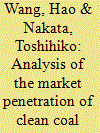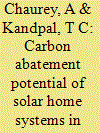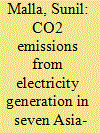|
|
|
Sort Order |
|
|
|
Items / Page
|
|
|
|
|
|
|
| Srl | Item |
| 1 |
ID:
088059


|
|
|
|
|
| Publication |
2009.
|
| Summary/Abstract |
This paper discusses policy instruments for promoting the market penetration of clean coal technologies (CCTs) into China's electricity sector and the evaluation of corresponding effects. Based on the reality that coal will remain the predominant fuel to generate electricity and conventional pulverized coal boiler power plants have serious impacts on environment degradation, development of clean coal technologies could be one alternative to meet China's fast growing demand of electricity as well as protect the already fragile environment. A multi-period market equilibrium model is applied and an electricity model of China is established to forecast changes in the electricity system up to 2030s. Three policy instruments: SO2 emission charge, CO2 emission charge and implementing subsidies are considered in this research. The results show that all instruments cause a significant shift in China's electricity structure, promote CCTs' competitiveness and lead China to gain great benefit in both resource saving and environment improvement. Since resource security and environment degradation are becoming primary concerns in China, policies that could help to gain generations' market share of advanced coal-based technologies such as CCTs' is suitable for the current situation of China's electricity sector.
|
|
|
|
|
|
|
|
|
|
|
|
|
|
|
|
| 2 |
ID:
088055


|
|
|
|
|
| Publication |
2009.
|
| Summary/Abstract |
The European Commission has proposed a new Renewable Energy Directive, which includes flexibility provisions allowing the cost-effective attainment of the ambitious target for renewable energy of 20% of energy consumption, which has been set for the year 2020. One of the flexibility provisions currently being considered is to allow countries to reach their individual targets by buying their renewable electricity deployment deficit from other countries with a surplus (i.e., with a renewable electricity deployment above their targets). This trade is likely to take the form of an exchange in guarantees of origin (GOs). GOs are currently implemented in Member States to fulfil the Renewable Electricity Directive requirement that each country has a system that allows the tracing of the source of each kWh of renewable electricity and informs on this source. Although the recent and tiny literature on the analysis of GO trading has focused on trade between firms, the exchange of GOs between governments has not received a comparable attention. This paper analyses the advantages and drawbacks of a system of government trading of GOs with respect to company trading.
|
|
|
|
|
|
|
|
|
|
|
|
|
|
|
|
| 3 |
ID:
088058


|
|
|
|
|
| Publication |
2009.
|
| Summary/Abstract |
Although Argentina came late to the biofuels revolution, a series of measures taken recently at federal and provincial government level have created new opportunities. New federal laws on biofuels promotion have sparked an investment boom. The main activity has been in the biodiesel sector-partly because diesel is the dominant fuel sector in Argentina, and partly because the country had already engineered a soy revolution over the past 15 years, becoming the world's largest exporter of soy oil and soy meal. Biodiesel allows this revolution to be extended-from soy as foodstuff to soy as fuelstock. The biodiesel revolution now underway promises to extend Argentina's latecomer advantages by combining greater scale and lower costs with introduced technical innovations such as genetically modified crops and no-till farming. In this way, Argentina can be seen to be demonstrating the superiority of biofuel production in countries of the South over the conditions obtaining in countries of the North-including superior resources availability, superior energetics and lower costs. Whereas Brazil has demonstrated its superiority in sugarcane-based ethanol, Argentina is about to demonstrate its superiority in soy-based biodiesel.
|
|
|
|
|
|
|
|
|
|
|
|
|
|
|
|
| 4 |
ID:
088032


|
|
|
|
|
| Publication |
2009.
|
| Summary/Abstract |
About 78 million rural households in India reportedly lack access to grid electricity. About 67 million of them use kerosene for lighting. Government of India is promoting the use of solar home systems (SHS) as one of the options for meeting lighting requirements in households in remote and less inhabited villages. About 363,399 SHS were reportedly disseminated across the country by December 2007. Apart from meeting the basic lighting need of the households, SHS also help in abating the emissions of green house gases (GHGs) by directly displacing the use of kerosene in households that currently use it for lighting. This study has attempted at estimating the CO2 mitigation potential of SHS in India by studying the potential for their diffusion and the appropriate baseline. Subsequently, the scope for cost reduction to the user due to carbon finance, if received, is also studied. It is found that carbon finance could reduce the effective burden of SHS to the user by 19% if carbon prices were $10/tCO2 and no transaction costs were involved in getting the carbon revenues. These benefits are also estimated for scenarios where transaction costs are incurred by the project proponent in getting the carbon benefits.
|
|
|
|
|
|
|
|
|
|
|
|
|
|
|
|
| 5 |
ID:
088040


|
|
|
|
|
| Publication |
2009.
|
| Summary/Abstract |
This paper presents measures and instruments for Germany to achieve the goal of 40% CO2-emission reduction until 2020 by reducing energy-related emissions by 224 million tonne (Mt). The most important measures in this regard are cuts in electricity generation (savings of 40 Mt), fuel switching and increased energy conversion efficiency (30 Mt) and an augmented 26% share of renewable energies in the provision of electrical energy (44 Mt). Average cost of the measures are at 50 euro per tonne avoided CO2, which corresponds to an additional monthly expenditure per household of less than 25 euro.
|
|
|
|
|
|
|
|
|
|
|
|
|
|
|
|
| 6 |
ID:
088019


|
|
|
|
|
| Publication |
2009.
|
| Summary/Abstract |
The Logarithmic Mean Divisia Index (LMDI) method of complete decomposition is used to examine the role of three factors (electricity production, electricity generation structure and energy intensity of electricity generation) affecting the evolution of CO2 emissions from electricity generation in seven countries. These seven countries together generated 58% of global electricity and they are responsible for more than two-thirds of global CO2 emissions from electricity generation in 2005. The analysis shows production effect as the major factor responsible for rise in CO2 emissions during the period 1990-2005. The generation structure effect also contributed in CO2 emissions increase, although at a slower rate. In contrary, the energy intensity effect is responsible for modest reduction in CO2 emissions during this period. Over the 2005-2030 period, production effect remains the key factor responsible for increase in emissions and energy intensity effect is responsible for decrease in emissions. Unlike in the past, generation structure effect contributes significant decrease in emissions. However, the degree of influence of these factors affecting changes in CO2 emissions vary from country to country. The analysis also shows that there is a potential of efficiency improvement of fossil-fuel-fired power plants and its associated co-benefits among these countries.
|
|
|
|
|
|
|
|
|
|
|
|
|
|
|
|
| 7 |
ID:
088046


|
|
|
|
|
| Publication |
2009.
|
| Summary/Abstract |
The restructuring of the Spanish oil industry produced a highly concentrated oligopoly in the retail gasoline market. In June 1990, the Spanish government introduced a system of ceiling price regulation in order to ensure that "liberalization" was accompanied by adequate consumer protection. By 1998, prices were left to the "free" market. This paper examines the pricing behaviour of the retail gasoline market using multivariate error correction models over the period January 1993 (abolishment of the state monopoly)-December 2004. The results suggest that gasoline retail prices respond symmetrically to increases as well as to decreases in the spot price of gasoline both over the period of price regulation (January 1993-September 1998) and over the period of free market (October 1998-December 2004). However, once the ceiling price regulation was abolished, cooperation emerged between the government and the major operators, Repsol-YPF and Cepsa-Elf, to control the inflation rate. This resulted in a slower rate of adjustment of gasoline retail prices when gasoline spot prices went up, as compared with the European pattern. Finally, the Spanish retail margin was by the end of our timing period of analysis, as in the starting years after the abolishment of the state monopoly, above the European average. This pattern confirms our political economic hypothesis, which suggests that the Spanish government and the oil companies were working together in reducing the inflation, in periods of rising oil and gasoline prices. It is also inferred that explaining the pricing pattern in energy markets may require different hypothesis than the classical perspective, involving just firms taking advantage of market power.
|
|
|
|
|
|
|
|
|
|
|
|
|
|
|
|
| 8 |
ID:
088031


|
|
|
|
|
| Publication |
2009.
|
| Summary/Abstract |
We propose a new method to evaluate the burden of oil price on any set of goods and services, and apply it to French households. This method takes into account the contribution of indirect energy consumption, which constitutes typically one half of the energy used by a typical French household. It yields an average burden of 4.4% in 2006, with a higher relative burden for households with lower income, older members and rural dwelling.
|
|
|
|
|
|
|
|
|
|
|
|
|
|
|
|
| 9 |
ID:
088044


|
|
|
|
|
| Publication |
2009.
|
| Summary/Abstract |
Turkish electricity sector has undergone significant institutional changes since 1984. The recent developments since 2001 including the setting up of a regulatory agency to undertake the regulation of the sector and increasing participation of private investors in the field of electricity generation are of special interest. This paper estimates cost functions and investigates the degree of scale economies, overinvestment, and technological progress in the Turkish electricity generation sector for the period 1984-2006 using long-run and short-run translog cost functions. Estimations were done for six groups of firms, public and private. The results indicate existence of scale economies throughout the period of analysis, hence declining long-run average costs. The paper finds empirical support for the Averch-Johnson effect until 2001, i.e., firms overinvested in an environment where there are excess returns to capital. But this effect was reduced largely after 2002. Technological progress deteriorated slightly from 1984-1993 to 1994-2001 but improved after 2002. Overall, the paper found that regulation of the market under the newly established regulating agency after 2002 was effective and there are potential gains from such regulation.
|
|
|
|
|
|
|
|
|
|
|
|
|
|
|
|
| 10 |
ID:
088052


|
|
|
|
|
| Publication |
2009.
|
| Summary/Abstract |
This paper presents a deterministic approach for performance assessment and optimization of power distribution units in Iran. The deterministic approach is composed of data envelopment analysis (DEA), principal component analysis (PCA) and correlation techniques. Seventeen electricity distribution units have been considered for the purpose of this study. Previous studies have generally used input-output DEA models for benchmarking and evaluation of electricity distribution units. However, this study considers an integrated deterministic DEA-PCA approach since the DEA model should be verified and validated by a robust multivariate methodology such as PCA. Moreover, the DEA models are verified and validated by PCA, Spearman and Kendall's Tau correlation techniques, while previous studies do not have the verification and validation features. Also, both input- and output-oriented DEA models are used for sensitivity analysis of the input and output variables. Finally, this is the first study to present an integrated deterministic approach for assessment and optimization of power distributions in Iran.
|
|
|
|
|
|
|
|
|
|
|
|
|
|
|
|
| 11 |
ID:
088056


|
|
|
|
|
| Publication |
2009.
|
| Summary/Abstract |
For the last 20 years, countless countries have been carrying out structural reforms in the natural gas industry, trying to achieve efficiency and economic rationality with the introduction of competition. The objective of the paper is to present an approach to the development of competition and infrastructure of the Brazilian natural gas industry. This approach is based on a market projection to 2011, on the international experience and on the characteristics of the Brazilian market, infrastructure and regulatory framework. Possible impacts of the proposed measures are also provided. According to the market projection carried out in this paper, in 2011 there will be a possible surplus of natural gas in the country, which includes a dependence diminishing of the Bolivian gas supply. This gas surplus, allied to an upcoming Gas Law and the trade liberalization in the states of São Paulo and Rio de Janeiro, can stimulate the development of competition, if some changes that proposed in this paper are made in the current Gas Bills. The approach proposed herein seeks to stimulate non-discriminatory open access, focused on information transparency and tariff regulation to help the development of infrastructure and competition.
|
|
|
|
|
|
|
|
|
|
|
|
|
|
|
|
| 12 |
ID:
088048


|
|
|
|
|
| Publication |
2009.
|
| Summary/Abstract |
The "Sustainable Development" aspect of the Clean Development Mechanism (CDM) under the Kyoto Protocol is examined, with regard to its current impact on crucial developmental issues.
The paper discusses the immediate and urgent global concerns of developmental needs, energy and climate change, whilst highlighting their influence on the poor in the developing world. The global responses to address the above concerns in terms of renewable energy technologies, policies and strategies that can be instrumental in addressing the issues are discussed, with main emphasis on the CDM under the Kyoto Protocol. The critical issue of whether the CDM can address poverty alleviation and sustainable development in developing countries is discussed in the context of existing market principles, transparency of the mechanism, economics and the daunting bureaucratic procedures involved.
The paper concludes that the CDM, if suitably modified, can go some way to address sustainable development and alleviate poverty for poor rural areas and not increase emissions by a focus on renewable energy technologies. This result can be achieved as the energy consumption of rural sectors is currently so small relative to developed economies that only small additional renewable energy generation capacities are needed to make a measurable difference.
|
|
|
|
|
|
|
|
|
|
|
|
|
|
|
|
| 13 |
ID:
088049


|
|
|
|
|
| Publication |
2009.
|
| Summary/Abstract |
A vast number of studies addressed the environmental degradation and economic development but not financial development. Moreover, as argued by Stern [2004. The rise and fall of the environmental Kuznets curve. World Development 32, 1419-1439] they present important econometric weaknesses. Using standard reduced-form modeling approach and controlling for country-specific unobserved heterogeneity, we investigate the linkage between not only economic development and environmental quality but also the financial development. Panel data over period 1992-2004 is used. We find that both economic and financial development are determinants of the environmental quality in BRIC economies. We show that higher degree of economic and financial development decreases the environmental degradation. Our analysis suggests that financial liberalization and openness are essential factors for the CO2 reduction. The adoption of policies directed to financial openness and liberalization to attract higher levels of R&D-related foreign direct investment might reduce the environmental degradation in countries under consideration. In addition, the robustness check trough the inclusion of US and Japan does not alter our main findings.
|
|
|
|
|
|
|
|
|
|
|
|
|
|
|
|
| 14 |
ID:
088037


|
|
|
|
|
| Publication |
2009.
|
| Summary/Abstract |
Energy-saving renovations of existing residential buildings have proven to be very helpful in alleviating the pressure of energy shortages and CO2 emission, but an economic analysis of the measures by using a life cycle cost (LCC) method is very important and necessary to determine whether to implement them or not. Based on thermal simulation and site investigation, the paper uses one urban existing residential building in Hangzhou city of China as the subject building, and analyzes the economic benefits from the energy-saving renovation measures through the LCC method.
The findings clearly show that the investigation of the factual electricity consumption of the subject building is very important to predict accurately the energy-saving effects and financial benefits of the measures for the building, because of the great discrepancy between in fact and in thermal simulation of the heating and cool loads, and the too cheap electricity price may hamper the development of energy-saving implementations in residential sector in China.
|
|
|
|
|
|
|
|
|
|
|
|
|
|
|
|
| 15 |
ID:
088060


|
|
|
|
|
| Publication |
2009.
|
| Summary/Abstract |
This paper assesses economic feasibility of utilizing community-managed degraded forest areas for raising energy crops and using the produced biomass for electricity production in the state of Madhya Pradesh, India through gasification technology. Three fast-growing species, three gasifiers of different capacities, three capital costs, and two scenarios of carbon payments were considered for analysis. Sensitivity and risk analyses were undertaken for determining the effects of variations in inputs on selected outputs. Results suggest that 5 million megawatt hour electricity can be generated annually which will prevent 4 million tons of carbon dioxide emissions per year. The production cost of a unit of electricity was found inversely related to the scale of production. The average cost of electricity at the consumer level produced using 100 kW gasifier was $0.15/kWh, which was greater than the price of electricity supplied from grid i.e. $0.08/kWh. The unit cost of producing electricity using Acacia nilotica was lowest among all the selected species. Technological advancements suitable government incentives are needed to promote electricity generation from forest biomass through gasification technology. This will help in spurring economic development and reducing overall ecological footprint of the state.
|
|
|
|
|
|
|
|
|
|
|
|
|
|
|
|
| 16 |
ID:
088026


|
|
|
|
|
| Publication |
2009.
|
| Summary/Abstract |
The purpose of this paper is to present and analyse the regulatory issues emerging from the newly launched programme of rural electricity access in India. We focus on two broad areas, namely regulatory issues related to the organisation/structuring of the activities and issues related to subsidy and tariffs.
The paper looks into the alternative organisational arrangements being used by the programme and identifies problem areas through a responsibility mapping. The tariff principle being followed by the programme is then analysed considering the alternative organisational forms and issues related to such pricing policies are identified. Possible alternative pricing options are then suggested.
The paper finds that while the franchisee model is an innovative idea, it raises issues that the regulators should be concerned with. The programme has so far relied on the simplest franchisee model because of its ease of implementation but a transition to more complex alternatives would require careful considerations.
|
|
|
|
|
|
|
|
|
|
|
|
|
|
|
|
| 17 |
ID:
088039


|
|
|
|
|
| Publication |
2009.
|
| Summary/Abstract |
Although the markets for ancillary services at the North American Independent System Operators are often structured in quite different ways there is an emerging set of core design elements that represent a rough consensus as to what the optimal design configuration for ancillary services should be, albeit with some regional variation. This paper looks back at how the design of ancillary services markets has recently evolved to put this development in context. Thereafter it examines the methods by which ancillary services are procured by highlighting the procurement practices at a number of different Independent System Operators, principally those in California, New York, New England, Texas and the PJM Interconnection, in an attempt to tease out the remaining reasons why the ancillary service markets are still so different. This is important as there are many innovations that are not rooted in regional differences but reflect genuine technical advances and economic efficiency gains and can be replicated across other ISOs to produce more efficient designs, greater reliability and lower costs.
|
|
|
|
|
|
|
|
|
|
|
|
|
|
|
|
| 18 |
ID:
088034


|
|
|
|
|
| Publication |
2009.
|
| Summary/Abstract |
This paper presents an hourly management method for energy generated in grid-connected wind farms using battery storage (Wind-Batteries systems). The method proposed is analysed technically and economically.
Electricity generation in wind farms does not usually coincide with the electrical demand curve. If the wind-power penetration becomes high in the Spanish electrical grid, energy management will become necessary for some wind farms. A method is proposed in this paper to adjust the generation curve to the demand curve by storing electrical energy in batteries during off-peak hours (low demand) and selling stored energy to the grid during peak hours (high demand).
With the results obtained and reported in this paper, for a Wind-Batteries system to be economically as profitable as a Wind-Only system, the selling price of the energy provided by the batteries during peak hours should be between 22 and 66 c€/kWh, depending on the technology and cost of the batteries. Comparison with flexible thermal generation has been performed.
Additionally, the results are compared with those obtained if using hydrogen (Wind-Hydrogen system, which uses an electrolyser, hydrogen tank, and fuel cell instead of batteries), concluding that the Wind-Batteries system is both economically and energetically far more suitable.
|
|
|
|
|
|
|
|
|
|
|
|
|
|
|
|
| 19 |
ID:
088035


|
|
|
|
|
| Publication |
2009.
|
| Summary/Abstract |
This paper presents an hourly management method for energy generated in grid-connected wind farms using battery storage (Wind-Batteries systems). The method proposed is analysed technically and economically.
Electricity generation in wind farms does not usually coincide with the electrical demand curve. If the wind-power penetration becomes high in the Spanish electrical grid, energy management will become necessary for some wind farms. A method is proposed in this paper to adjust the generation curve to the demand curve by storing electrical energy in batteries during off-peak hours (low demand) and selling stored energy to the grid during peak hours (high demand).
With the results obtained and reported in this paper, for a Wind-Batteries system to be economically as profitable as a Wind-Only system, the selling price of the energy provided by the batteries during peak hours should be between 22 and 66 c€/kWh, depending on the technology and cost of the batteries. Comparison with flexible thermal generation has been performed.
Additionally, the results are compared with those obtained if using hydrogen (Wind-Hydrogen system, which uses an electrolyser, hydrogen tank, and fuel cell instead of batteries), concluding that the Wind-Batteries system is both economically and energetically far more suitable.
|
|
|
|
|
|
|
|
|
|
|
|
|
|
|
|
| 20 |
ID:
088027


|
|
|
|
|
| Publication |
2009.
|
| Summary/Abstract |
One way to reduce greenhouse gas emissions from the transportation sector is to replace fossil fuels by biofuels. However, production of biofuels also generates greenhouse gas emissions. Energy and greenhouse gas balances of transportation biofuels suitable for large-scale production in Finland have been assessed in this paper. In addition, the use of raw materials in electricity and/or heat production has been considered. The overall auxiliary energy input per energy content of fuel in biofuel production was 3-5-fold compared to that of fossil fuels. The results indicated that greenhouse gas emissions from the production and use of barley-based ethanol or biodiesel from turnip rape are very probably higher compared to fossil fuels. Second generation biofuels produced using forestry residues or reed canary grass as raw materials seem to be more favourable in reducing greenhouse gas emissions. However, the use of raw materials in electricity and/or heat production is even more favourable. Significant uncertainties are involved in the results mainly due to the uncertainty of N2O emissions from fertilisation and emissions from the production of the electricity consumed or replaced.
|
|
|
|
|
|
|
|
|
|
|
|
|
|
|
|
|
|
|
|
|